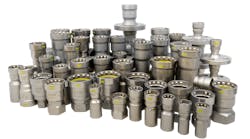The National Onsite Wastewater Recycling Association (NOWRA) has been formally seeking to understand the influence of water softeners and water conditioners on septic systems. Arguments have been aired that softeners are innocuous and, conversely, that softeners are detrimental to septic systems. Data of varying qualities exist supporting both arguments and many questions remain unanswered. NOWRA and the Water Quality Association (WQA) agreed to partner to determine the effects from the use of softeners in conjunction with onsite septic systems.
Both industries have pledged to seek workable solutions that will be beneficial and responsive to the consuming public we serve. Both NOWRA and WQA have formalized their processes and have formed task forces designed to address the issue. The mission of the NOWRA task force is, “to determine the influence of water softeners and water conditioning equipment on onsite systems, propagate a professional synergy with the WQA, and define useful solutions where needed.”
In order to determine the influence of softeners and conditioners on onsite systems, a process is being proposed by the NOWRA task force and WQA. First, the task force will seek to compile and understand what is known about softeners and onsite systems. Secondly, efforts will be made to devise research protocols and design practical methodology to evaluate the relationship between water treatment and potential effects on onsite system performance. Third, the task force will seek funding and coordinate the implementation of the research.
To that end, two symposia were held, one at NOWRA in Cleveland and another at the WQA in suburban Chicago. Data supporting either argument were solicited by Jim Converse, professor emeritus, University of Wisconsin. Proceedings from the Cleveland symposium are available. Following that, WQA held a symposium featuring speakers from the onsite community, who informed the water treatment industry about onsite technology and the regulatory framework under which it works.
This effort constituted a good beginning. After both symposia, however, neither side felt adequate data exist to settle the question. Therefore, field experiences were determined to be necessary. It was agreed that sites which have both onsite systems and water softeners should be visited by onsite as well as water conditioning professionals so that both these professionals could teach each other about their respective equipment and industries, and thus create a useful synergy.
To that end Dr. Bruce Lesikar, Texas A&M University and the Consortium of Institutes for Decentralized Wastewater Treatment (CIDWT), and D.J. Shanahan, Sharp Water/Ecowater Sys tems Co., Dover, Del., adapted a survey instrument for use in the field. The instrument was originally created as part of the CIDWT O&M Service Provider Program for use by professionals to analyze the nature of effluent entering residential septic systems. This instrument was described to the public at the NOWRA conference in August 2006.
(CIDWT is a group of academic personnel and private industry advisors who cooperate on research and outreach education and training in the field of decentralized wastewater treatment. Most CIDWT members are also members of the NOWRA.)
A self-funded pilot study was planned and conducted through the leadership of Tom Konsler of the Orange County Health Department, North Carolina, David Lindbo and Nancy Deal, both of North Carolina State University, and CIDWT.
The goal of the exercise was to develop a protocol for collecting samples and measurements from septic tanks and water treatment units to study the effect of water softener backwash on septic tank performance. A protocol developed with a small number of sites could be used for broader studies that might offer insight into the appropriate BMPs for septic systems serving residences that employ ion-exchange water treatment. A willing neighborhood in Orange County, N.C., was chosen as the testing ground presenting septic systems both with and without the addition of softener backwash.
The team developed an extensive protocol with input from many sources, including personnel from CIDWT, NOWRA, and WQA. The pilot survey was conducted in July 2007 with observers from these organizations in attendance and members of WQA cooperated by performing evaluations of water treatment devices. Laboratory analysis was paid for by Orange County Health Department and N.C. State University. The results of the study will be released after the data have been analyzed and published.
This pilot study yielded an important opportunity to evaluate actual field conditions with collaboration from experts from both industries and was designed to facilitate development of a larger, deeper investigation defining how different influents affect septic system performance. This kind of necessary work will assist this field in defining these more difficult, but basic issues. A larger protocol will be released by the authors and their collaborators. The protocol will address softeners as well as the larger issue of onsite system evaluation and troubleshooting. North Carolina State University and Orange County Environmental Health are pursuing funding to conduct additional surveys.
In summary, the “softener” project has gained much interest. It is still controversial. NOWRA and WQA intend to work cooperatively to identify the extent of the influence softeners and conditioners have on onsite systems and thus provide consumers with solid answers to the remaining questions. These groups intend to create and sustain a professional synergy and propose that our industries support each other in these important investigations. CIDWT and its affiliates will also cooperate through their support of objective scientific research.
Matt Byers, PhD, is chairman of the Technical Practices Committee of NOWRA. Joe Harrison, P.E., CWS-VI, is technical director of the Water Quality Association.

